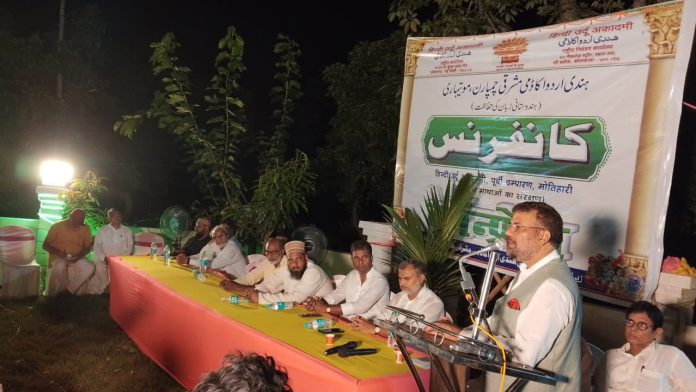Now Linguistic Satyagraha, Champaran has always been a symbol of India’s awakening, truth, and revolution. It was this very soil that gave Mahatma Gandhi the courage a century ago to rise against British tyranny — against the forced cultivation of indigo — and to ignite the first spark of freedom.
By Qalam Times News Network | Patna | October 17, 2025
Today, Champaran once again stands at the threshold of a new history. But this time, the battleground is not political — it is linguistic. And at the center of this new movement is one name: Shamim Ahmed, who has spent the last thirty years working for the preservation and progress of Indian languages. Now, he has launched a Linguistic Satyagraha that could shake the nation’s collective conscience.

His demand is simple yet profound: Hindi should be recognized as the national language, and Urdu as the second national language of India.
This is not a call for linguistic superiority or religious pride — it is a call for justice, balance, and cultural harmony.
The Visionary Behind the Movement
Shamim Ahmed is not just a leader; he’s a thinker and a doer. His efforts have already brought tangible results — under his leadership, Urdu was granted the status of a second official language in West Bengal, a landmark achievement in India’s linguistic politics. Now, from Champaran, he aims to take this Linguistic Satyagraha to the national stage, restoring both Hindi and Urdu to their rightful places.

To him, languages are not tools of division — they are bridges of unity.
He says: “Hindi and Urdu are not two rivals; they are two waves of the same cultural river.”
This vision challenges the very divide that the British once created to strengthen their rule.
How the Divide Began
The Hindi–Urdu conflict was never truly linguistic — it was political. The British knew that the strongest bond among Indians was their shared language. To weaken this unity, they employed their Divide and Rule strategy, linking language with religion.

Before this manipulation, the common tongue of North India was known as Hindvi, Rekhta, or Dehlavi — a language spoken by everyone, regardless of faith. Amir Khusro wrote in it, Kabir composed his dohas in it, Mir and Sauda wrote ghazals in it. It was the thread that tied together India’s cultural fabric.
But the British deliberately split that unity — branding Urdu as the “language of Muslims” and Hindi as the “language of Hindus.” In doing so, they divided one language, and with it, one nation’s heart.
The Lingering Impact of Colonial Poison

This colonial poison ran so deep that even after independence, its effects lingered. Urdu was gradually pushed out of schools, government institutions, and public spaces — dismissed as a “minority language.” Meanwhile, Hindi was promoted, but often at Urdu’s expense.
This imbalance weakened the cultural symmetry that defined India. Shamim Ahmed’s Linguistic Satyagraha seeks to restore that equilibrium.
He believes that a nation divided by language can never truly unite. For him, Hindi and Urdu are not two bodies — they are two reflections of one soul. Hindi is the identity of India; Urdu is its spirit.
A Movement of Creation, Not Protest

What makes this Linguistic Satyagraha so powerful is that it isn’t rooted in anger but in creation. Shamim Ahmed has announced a plan to establish libraries in every district, where books in Hindi, Urdu, and other Indian languages will be freely available. His goal is to revive the culture of reading — because, as he says, “A nation connected to its books can never be enslaved.”
This isn’t just a movement for linguistic justice; it’s a movement for intellectual awakening.
From Gandhi’s Satyagraha to a New One
If Gandhi’s Champaran Satyagraha was a fight against the slavery of indigo, Shamim Ahmed’s Linguistic Satyagraha is a fight against the slavery of thought.
Gandhi said: “Defeat injustice through truth and nonviolence.”
Shamim Ahmed says: “Defeat hatred through knowledge and love.”
Both movements share the same goal — freedom. Gandhi fought for political liberation; Shamim Ahmed fights for intellectual liberation.
The British divided India through language — Shamim Ahmed aims to unite it through language. Like Gandhi, he seeks to free people from mental chains, not just physical ones.
Champaran Then and Now — From Gandhi to Shamim Ahmed
A century ago, Champaran became the birthplace of India’s political awakening. Today, it’s becoming the birthplace of India’s linguistic awakening.
Where Gandhi launched the first Satyagraha for farmers’ dignity, Shamim Ahmed launches a Linguistic Satyagraha for the dignity of India’s languages.
He reminds us: “Languages are meant to connect hearts, not divide them. Hindi is our identity, Urdu is our soul — without both, India’s picture is incomplete.”
Unmasking the Colonial Legacy
For Shamim Ahmed, this is not just about language — it’s about cultural survival. He exposes the bitter truth that the so-called Hindi–Urdu divide is an artificial construct born of British manipulation.
During the early colonial period, North India spoke one common language — Hindustani. Religion and language were never at odds. But once the British realized that this unity was dangerous to their rule, they institutionalized division through schools, courts, and administration.
By making Urdu the “Muslim language” and Hindi the “Hindu language,” they sowed not only social but also psychological division. Shamim Ahmed’s Linguistic Satyagraha seeks to reverse that very mental colonization.
He often says: “The British did not enslave us with swords, but with sentences — through laws, textbooks, and policies.”
They planted hatred through words, and it’s through words — through language — that he now seeks to uproot it.
Hindi and Urdu: Two Names, One Heritage
Historically, there is no conflict between Hindi and Urdu.
Urdu borrowed grace from Persian and Arabic; Hindi drew strength from Sanskrit. Both were nourished by the same Indian soil — where Khusro, Kabir, and Mir sang songs of unity.
Film, poetry, and music have long blended the two into one shared emotional language — Hindustani.
The divide, therefore, is political, not cultural. Shamim Ahmed’s mission is to heal this divide and restore linguistic balance.
He believes: “If one language dies, the other will not survive either — because they are not two trees, but two branches of the same trunk.”
Building a New Intellectual Freedom
Shamim Ahmed’s Linguistic Satyagraha is not about shouting slogans or staging protests. It’s about understanding, respect, and dialogue.
He envisions a future where Hindi receives its rightful status as the national language, and Urdu its rightful place as the second national language — together representing the shared cultural and emotional landscape of India.
This is not merely a demand — it’s a national necessity.
Until we free our languages from political prejudice, we cannot safeguard our cultural identity.
A New Dawn from Champaran
Champaran, the sacred land that once gave India its first lesson in truth and justice, is once again rising — not for indigo fields this time, but for linguistic equality and cultural dignity.
From this soil, Shamim Ahmed, the “Qaed – Urdu,” has launched his Linguistic Satyagraha — demanding that Hindi be declared the national language and Urdu the second national language. His call is not just for linguistic rights, but for the revival of India’s intellectual unity.
He believes that languages are the heart of a nation — and a heart cannot be divided.
The Second Freedom Movement
When asked what his movement truly represents, Shamim Ahmed smiles and says:
“The British drew lines to divide us — now it’s time to erase those lines and revive the language of our ancestors.”
His dream is of an India where Hindi and Urdu coexist, not as rivals, but as partners — representing the literature, culture, and spirit of the land.
The day this dream comes true, it will mark India’s second independence:
The freedom of languages, the freedom of hearts, and the freedom of identity.







